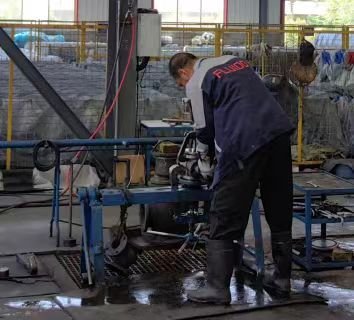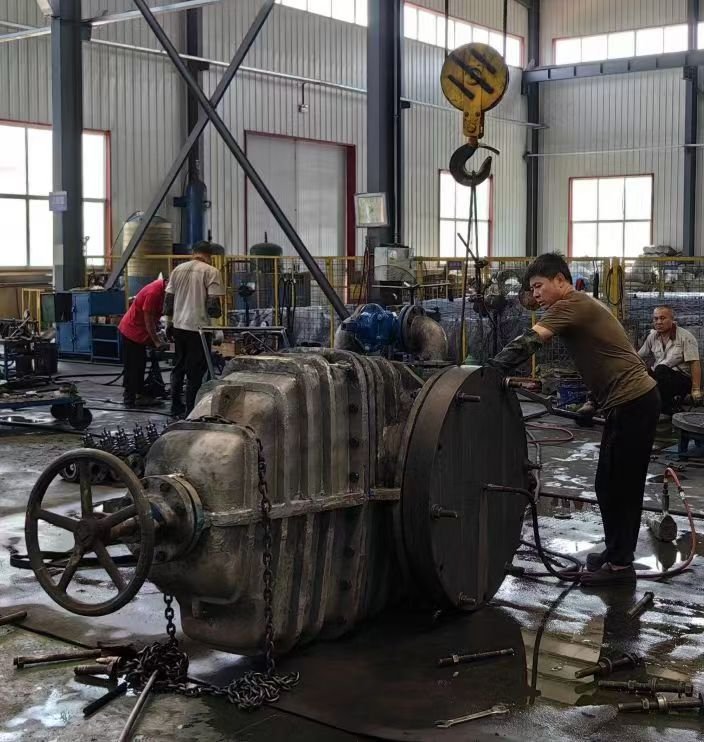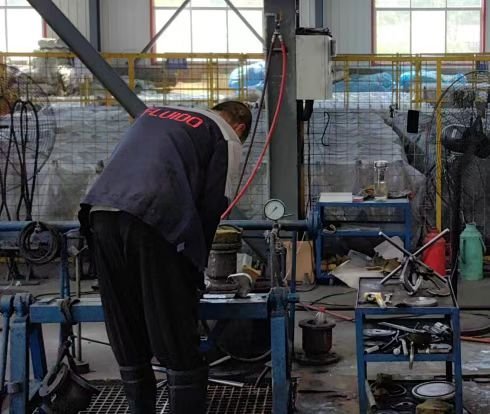Export Office: 21Floor, No.5 Nanhai Zhi Road,Qingdao, Shandong ,China
Work Shop: Beian Industrial zone, Qingdao,Shandong,China
+86 532 88550858
Martin
Inquiry now
Hydrostatic testing is crucial, for evaluating the strength and reliability of parts like pipes, tanks and connections. During this process the system is filled with a specified fluid, like water. Exposed to test pressures to ensure that the equipment can withstand pressures detect leaks and identify any defects that could impact safety or effectiveness.

Maintaining safety during testing is crucial, for the reliability and durability of systems. Any mishaps or malfunctions during the testing process can lead to injuries damage to equipment and expensive downtimes. This is why following safety procedures is absolutely essential. By ensuring preparation and precise execution it helps minimize risks and instill confidence that the system being tested will function efficiently under operating conditions. Therefore prioritizing safety measures is not advantageous but a key factor, in accomplishing successful hydrostatic testing.
Hydrostatic testing is widely used across industries. Oil and gas pipelines often undergo these tests to ensure that flange connections and other parts are secure and free of leaks. In plants hydrostatic testing is important, for checking the strength of storage tanks and equipment. Similarly, in plumbing this type of testing is crucial to make sure that pipes and connections can withstand water pressures without any leaks. Essentially any industry that depends on pressurized systems can find value in testing to uphold safety and performance standards.
Prior, to commencing a test it is crucial to gather all the required equipment and tools. You must have access to a supply of the testing medium, water. A high pressure pump is necessary for injecting the medium into the system and reaching the desired test pressures. Pressure gauges and relief valves are essential, for pressure monitoring and control. In cases of flange connections, specific adaptors or blind flanges may be needed to seal and isolate the test zone.

Prior, to performing testing it's crucial to examine the flange connections. Confirm that all bolts are tightened correctly and the gasket is in the position to guarantee a seal. Conduct a check, for any indications of rust, harm or deterioration that could impact the efficiency of the flange connection. By dealing with these concerns you can minimize the chance of issues arising during the test.
Ensure that the system and parts, under examination such as flange connections are designed to handle the test pressures. Refer to the manufacturer specifications and industry standards to validate that the materials are capable of withstanding the intended pressures. This stage is crucial, in avoiding pressure, which could result in malfunctions and dangerous situations.
Selecting an appropriate testing medium is essential for accurate and safe hydrostatic testing. Water is commonly used due to its incompressibility and availability, but in some cases, other fluids like oil or glycol mixtures might be preferred for their specific properties. Ensure that the medium chosen is compatible with the materials of the flange connections and other system components to prevent chemical reactions or corrosion during the test.
Start by isolating the section of the system that includes the flange connections to be tested. Close all applicable valves and use isolation blinds if necessary to ensure the section is entirely separated from the rest of the system. This prevents accidental pressurization of connected components that are not meant to be tested.
To enhance safety, incorporate pressure relief devices within the tested section of the system. These devices will avert overpressurization by releasing excess pressure, thus safeguarding flange connections and other components from damage or rupture. Precisely calibrated pressure relief valves are essential for maintaining control over the testing procedure.
When filling the system with the chosen test medium, ensure that no air pockets remain within the tested section. Air pockets can lead to inaccurate pressure readings and potential safety hazards. Slowly fill the system and use vents and bleed valves near the flange connections to eliminate trapped air.
Carefully monitor the filling rate to prevent overpressure situations as the test medium is introduced into the system. Gradual filling allows for better control and avoids sudden spikes in pressure that could damage the flange connections. Maintain a steady pace and use pressure gauges to keep an eye on the pressure levels throughout the filling process.

Once the system is filled and air pockets are removed, begin increasing the pressure gradually. Incrementally raise the pressure to the test limit specified for the flange connections. This controlled increase ensures that the system gradually adjusts to the stress without abrupt changes that could cause damage.
Keep the system at the designated test pressure for the necessary period as outlined by industry standards or manufacturer guidelines. This step facilitates a comprehensive examination of the flange connections under pressure, confirming their strength and pinpointing any possible vulnerabilities.
Conduct a detailed visual inspection of the flange connections and surrounding areas while the system is at test pressure. Look for any signs of leakage, such as water droplets, damp areas, or changes in pressure gauge readings. A thorough visual inspection is a straightforward yet effective method for detecting obvious leaks and defects.
For more precise detection of leaks or defects, employ specialized detection tools. These may include ultrasonic leak detectors, dye penetrants, or pressure decay testing equipment. These tools can identify small or hidden defects that might not be visible during a visual inspection, offering a more comprehensive evaluation of the flange connections' integrity.
After completing the hydrostatic test, the system must be depressurized safely. This involves gradually releasing the pressure to prevent any sudden drops that might cause shock to the flange connections. Begin by slowly opening designated pressure relief valves. This cautious approach ensures that any residual pressures are relieved without damaging system components. Continue monitoring the pressure gauges during the depressurization process to ensure that the pressure is uniformly decreasing across the system. Proper adherence to these procedures minimizes the risk of injury and equipment damage.
After the system has been depressurized, the next step involves draining the test medium. Open the designated drainage valves and drains to remove the test fluid from the system. For flange connections, make sure all sections are fully drained to avoid any trapped fluid. Once drained, proceed to dry the system using compressed air or other drying techniques. This step is essential to prevent rust, corrosion, or contamination within the flange connections and the entire system, ensuring it is ready for further use or storage.
Comprehensive documentation of the hydrostatic test is essential. Record the pressures applied, durations, and visual or instrumented inspection results. Detail any observed leaks or defects, particularly around flange connections. This documentation serves as a critical reference for system integrity and future inspections. Generate a report summarizing the findings, including any corrective actions taken. This report not only provides a record of compliance with safety and operational standards but also helps in predictive maintenance and troubleshooting.
If any issues were identified during the hydrostatic test, prompt corrective actions are necessary. For flange connections, this may include retorquing bolts, replacing gaskets, or addressing any detected leaks or weaknesses. Prioritize the rectification of these issues before bringing the system back into service. Detailed re-inspection and, if necessary, retesting should be performed to ensure that all corrections meet safety standards and the integrity of the flange connections and the broader system is fully restored.
Adhering to industry standards is vital for safe and effective hydrostatic testing. Refer to guidelines set by organizations such as ASME, API, and OSHA for specific procedures and pressure limits related to flange connections. Compliance ensures that testing procedures are standardized, minimizing risks and maximizing the reliability of the results. Regularly update your practices to align with any changes in industry standards, ensuring ongoing safety and efficacy in hydrostatic testing protocols.
The reliability of hydrostatic testing is significantly influenced by the condition of the testing equipment. Conduct regular maintenance and calibration of pumps, pressure gauges, relief valves, and other essential tools. Properly maintained equipment ensures accurate pressure readings and effective operation during the test. For flange connections, ensure that any specialized flange testing adaptors or fixtures are in good condition and appropriately certified for use. Regular checks and servicing prevent equipment failure and enhance the overall safety and accuracy of the testing process.
It's crucial to train staff, on safety protocols and procedures when performing tests safely. Make sure everyone participating in the tests understands how to use the equipment what to do in emergencies and the proper way to handle flange connections. Conduct safety drills. Keep the team informed of any protocol updates to stay ready, for unexpected situations. Informed and skilled staff can spot problems sooner and respond effectively to ensure a secure testing environment.
QINGDAO FLUIDO is a known company, in the control solutions industry, known for its dedication to excellence and creativity. They focus on offering a variety of products tailored to meet standards. A standout aspect of QINGDAO FLUIDOs expertise lies in producing and delivering components needed for testing such as top notch flange connections. Their strong emphasis, on safety and effectiveness guarantees that their offerings are dependable and effective.
QINGDAO FLUIDO provides a variety of products, for hydrostatic testing purposes. Their flange connections are designed to endure pressures guaranteeing performance during testing. Moreover QINGDAO FLUIDO offers solutions that cater to industrial requirements ensuring seamless integration, with current systems.
QINGDAO FLUIDO goes beyond selling products by offering a range of support services to their customers. They provide assistance to help customers select the products, for hydrostatic testing offer guidance on installation and provide maintenance support. Their team of experts is available for on site training and consultation to ensure that customers are well prepared to conduct tests efficiently. Partnering with QINGDAO FLUIDO gives clients access, to top notch products and reliable support improving the safety and performance of their operations.
By adhering to these guidelines and established techniques conducting testing, on flange connections can be carried out securely and efficiently guaranteeing the soundness and dependability of industrial systems. Employing top notch products and assistance from companies such, as QINGDAO FLUIDO also boosts the efficacy and security of these processes.
Export Office: 21Floor, No.5 Nanhai Zhi Road,Qingdao, Shandong ,China
Work Shop: Beian Industrial zone, Qingdao,Shandong,China
+86 532 88550858
Martin
© 2020 Qingdao Fluido Industrial Co.,Ltd. All Rights Reserved. Qingdao fluido valve

